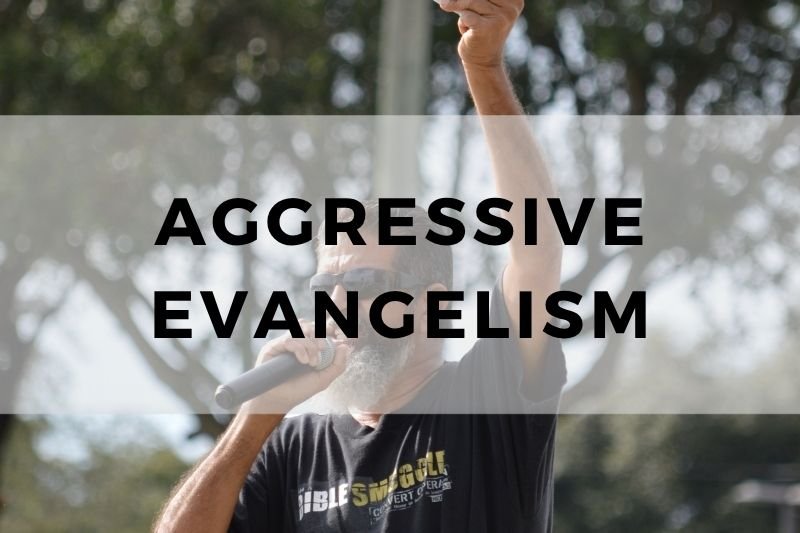
Aggressive evangelism is a direct and forceful way of sharing the Christian faith. It aims to reach people quickly and clearly with the message of Jesus Christ. This approach often involves boldness and urgency. Some see it as effective, while others find it off-putting. Understanding what aggressive evangelism is and when it works helps Christians use it wisely. This article explores its meaning, benefits, challenges, and real-life examples. The goal is to provide a balanced view of this style of evangelism and its impact on individuals and communities.
What Is Aggressive Evangelism?
Definition
Aggressive evangelism is a style of sharing the Christian faith that uses direct, bold, and sometimes confrontational methods. It focuses on clear, urgent communication of the gospel message. Unlike gentle or passive approaches, aggressive evangelism does not shy away from challenging people or pressing for a response. The goal is often immediate awareness or decision. This method can involve street preaching, personal confrontation, or public campaigns. While the tone may feel forceful, the intent is to save souls and spread the Christian message effectively.
Key Characteristics
Aggressive evangelism is marked by urgency, boldness, and persistence. It often involves direct calls to repentance and faith in Jesus. Preachers or evangelists may use strong language or challenge existing beliefs openly. The approach can be loud, visible, and attention-grabbing. It requires courage and confidence from the messenger. There is often a focus on the consequences of rejecting the gospel. Follow-up efforts are sometimes less emphasized but are critical for lasting impact. This style values results and clear decisions over slow, relational approaches.
Historical Context
Aggressive evangelism has roots in early Christian preaching, where apostles boldly confronted crowds with the gospel. Throughout history, revival movements often used forceful preaching to awaken spiritual interest. The Great Awakenings and some modern crusades used aggressive tactics to reach large audiences quickly. However, the style has also faced criticism for being too harsh or disrespectful. Different cultures and periods have shaped how aggressive evangelism is practiced. Today, it remains a controversial but sometimes effective tool in spreading Christianity.
When Aggressive Evangelism Can Work
#1. In Receptive Cultures
Aggressive evangelism tends to work well in cultures open to new ideas or spiritual messages. In these environments, people may already be curious or searching for meaning. The direct and clear presentation of the gospel can meet that desire for answers. Receptive cultures often have fewer barriers to discussing faith openly. Here, boldness can inspire quick responses and deeper interest. However, even in open cultures, respect and sensitivity remain important to avoid backlash.
#2. During Urgent Times
Times of crisis or major social change create urgency for spiritual answers. Natural disasters, wars, or economic hardships can make people more open to hearing about hope and salvation. Aggressive evangelism, with its urgent call to respond, can connect with people’s deep need for help. The clear message of Jesus as a savior gains urgency in these moments. When timed well, this approach can lead to rapid spiritual decisions and revival.
#3. With Deep Conviction
Evangelists who practice aggressive evangelism often have strong conviction about the gospel’s truth and importance. Their passion drives their bold approach. When combined with genuine care and knowledge, this conviction can be persuasive. People tend to respond to honesty and certainty. Without deep conviction, aggressive methods can feel empty or pushy. When rooted in true faith, the boldness communicates urgency without losing credibility.
#4. Among the Unreached
In areas where Christianity is little known or actively resisted, aggressive evangelism can break through silence or indifference. Clear and persistent sharing cuts through cultural barriers and apathy. It forces attention and opens doors for further conversation. However, this approach can also cause conflict if not done wisely. Aggressive evangelism among the unreached requires courage, preparation, and often support from the wider Christian community.
#5. Backed by Follow-Up
Aggressive evangelism’s impact is stronger when paired with consistent follow-up. Initial bold efforts may spark interest or decisions, but ongoing teaching, support, and discipleship are necessary for lasting change. Follow-up helps new believers grow and strengthens their faith. Without it, decisions made under pressure can be shallow or temporary. Successful aggressive evangelism balances urgency with patient care after the initial encounter.
Impact of Aggressive Evangelism on Individuals and Communities
#1. Initial Reactions
People often have strong reactions when faced with aggressive evangelism. Some respond with curiosity and openness, appreciating the clear message. Others feel shocked, uncomfortable, or even offended by the bold approach. The directness can catch people off guard. Initial reactions depend on the listener’s background, beliefs, and cultural context. For some, aggressive evangelism breaks through spiritual apathy. For others, it can create resistance or rejection. Understanding these reactions helps evangelists prepare for a range of responses.
#2. Long-Term Effects
The long-term effects of aggressive evangelism vary widely. When followed by proper teaching and support, it can lead to genuine faith and spiritual growth. However, if follow-up is lacking, decisions made under pressure may not last. Some new believers may struggle with doubts or leave the faith. In communities, aggressive evangelism can spark revival or renewed interest in Christianity. On the other hand, it can cause confusion or division if people feel pushed or misunderstood.
#3. Shaping Christianity’s Image
Aggressive evangelism influences how Christianity is viewed by both believers and outsiders. For some, it shows passion, commitment, and boldness. For others, it can appear harsh, intolerant, or disrespectful. The style can affect the church’s reputation positively or negatively depending on how it is practiced. Churches using this approach must balance zeal with respect to maintain a positive image and avoid alienating people.
#4. Unity or Division Among Believers
Within the Christian community, aggressive evangelism can unite some and divide others. Some believers see it as a necessary, effective way to spread the gospel. Others worry it damages relationships or conflicts with the message of love and gentleness. Differences in opinion about style and tone can cause tension. Healthy dialogue among believers about aggressive evangelism can promote understanding and cooperation.
#5. Cultural and Social Strain
Aggressive evangelism may create tension in diverse cultural and social settings. Direct confrontation of beliefs can lead to misunderstandings or conflict. In pluralistic societies, it risks offending people of other faiths or none. The social strain can impact community relations and even lead to backlash against Christians. Evangelists need cultural sensitivity and wisdom to avoid unnecessary harm while sharing their faith boldly.
Criticism and Concerns of Aggressive Evangelism
#1. Passion vs. Respect
One common criticism is that aggressive evangelism sometimes sacrifices respect for passion. While zeal for sharing the gospel is important, it can come across as pushy or disrespectful. This may turn people away instead of drawing them closer. Respecting others’ beliefs and boundaries is essential, even when presenting the truth boldly. Without respect, aggressive methods risk damaging relationships and Christian witness.
#2. Emotional Tactics
Aggressive evangelism can rely heavily on emotional appeals or fear-based messages. Using guilt, shame, or fear of punishment may force quick decisions but can lead to shallow faith. Emotional tactics may not create genuine belief or lasting commitment. Critics argue that the gospel should be shared with love and reason, not manipulation. True conversion involves the heart and mind, not just emotional pressure.
#3. Fragile Conversions
Conversions resulting from aggressive evangelism can be fragile. When people feel pressured or rushed, their commitment may lack depth. Without proper discipleship, these new believers may drift away or struggle with doubts. Critics worry that aggressive methods prioritize numbers over spiritual growth. Lasting faith requires time, teaching, and nurturing beyond the initial decision.
#4. Alienating Others
Aggressive evangelism can alienate those it aims to reach. Some people find confrontational or forceful tactics off-putting. It may create barriers rather than open doors for dialogue. Alienation can harm the church’s ability to build bridges and form lasting relationships. A more relational and gentle approach may be more effective in some contexts.
#5. Misusing Scripture
Another concern is the misuse of Scripture in aggressive evangelism. Selective or out-of-context Bible verses may be used to pressure or intimidate listeners. This can distort the gospel message and lead to misunderstanding. Proper interpretation and application of Scripture are vital. Evangelism should teach the whole gospel, not just parts that support urgency or confrontation.
Examples of Aggressive Evangelism
#1. Urban Street Preaching
Urban street preaching is a common form of aggressive evangelism. Preachers stand in busy public places and deliver loud, direct messages about sin, salvation, and repentance. This method grabs attention quickly and reaches large crowds. It often involves confrontational language and calls for immediate response. Street preaching can spark debate and strong reactions from listeners. It is effective in reaching people who might not attend church or seek spiritual conversations. However, it requires boldness and thick skin from the preacher.
#2. Revival Crusades
Revival crusades are large-scale evangelistic events often led by charismatic preachers. These gatherings use passionate sermons, music, and public invitations to convert attendees. The style is direct and urgent, pressing people to make quick faith decisions. Crusades can lead to mass conversions and spiritual awakenings. Historically, they played a major role in spreading Christianity. Critics sometimes see them as emotional or manipulative, but supporters value their impact on thousands of lives.
#3. Confrontational Witnessing
Confrontational witnessing involves engaging individuals in direct dialogue or debate about faith. Evangelists challenge doubts, objections, and alternative beliefs openly. The goal is to expose errors and bring people to a clear understanding of the gospel. This method requires deep biblical knowledge and confidence. It can lead to strong convictions or cause resistance. When done with grace, it sharpens faith; done poorly, it may offend.
#4. Bold Acts in Hostile Areas
In places where Christianity faces opposition, aggressive evangelism can take the form of bold, public acts of witness. This may include open-air preaching, distribution of gospel materials, or public prayer in hostile environments. Such acts demonstrate courage and commitment. They often attract attention and can inspire local believers. However, they also carry risks, including persecution or backlash. Boldness must be balanced with wisdom to protect both evangelists and new believers.
#5. Provocative Media Outreach
Aggressive evangelism extends to media through provocative campaigns on radio, TV, or social platforms. These messages challenge listeners with urgent calls to repent and follow Christ. They often use strong language, vivid imagery, or controversial topics to get noticed. Media outreach can reach millions quickly but risks backlash if perceived as offensive. Effective campaigns combine boldness with clear, truthful messaging to spark interest and conversion.
Closing Thoughts
Aggressive evangelism is a powerful tool when used thoughtfully. It can break through barriers and reach people who might not hear the gospel otherwise. However, its effectiveness depends on context, conviction, and follow-up. The approach carries risks, including alienation and shallow conversions, so it must be balanced with respect and care. Churches and evangelists should consider when and how to use aggressive methods wisely. Ultimately, the goal is to share the message of Jesus clearly and lovingly, helping people grow in faith and live transformed lives.
